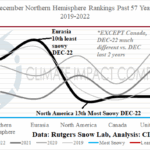A Cautionary Note to Natural Gas Traders as Arctic Air Can Return Quickly
01/03/2023, 1:42 pm EST
Eurasia Snow Cover 10th Least Snowy in December 2022; Last Week of December 4th Least Snowy
01/07/2023, 10:15 am EST


Fig. 1-3: Temperature anomalies across Europe for meteorological winter 2022-23 (so far), the 15-day temperature anomaly forecast and the correlation of the warm climate to the record warm Mediterranean Sea.
Europe discussion: During the past 10 years a semi-permanent upper-level low-pressure trough has occupied the North Atlantic basin near and south of Greenland. The upper trough position is associated with a semi-permanent cool pool of ocean water in this region surrounded by anomalous warm water of the past 2 decades and referred to by climate scientists as the North Atlantic warm hole (NAWH). To compensate, the atmosphere has a tendency to produce a downstream upper-level high-pressure ridge over Europe. The NAWH upper trough has shifted toward Western Europe during the 2022-23 cold season forcing an upper ridge over South and East Europe. The amplitude of the trough/ridge features has been impressive. The upper ridge has caused record warmth in Europe so far this winter season (Fig. 1) with more on the way in the 15-day outlook (Fig. 2). The upper ridge is well-correlated with record warm SSTA across both the Mediterranean and Black Sea (Fig. 3). While large regions of warm SSTA are well-correlated with warming (and drying) upper-level high-pressure ridge areas, if an upper trough comes along and is positioned correctly, extreme precipitation can occur as above normal low atmospheric moisture associated with very warm SSTA is entrained into the low-pressure area. This pattern is an example of the climate change era whereas long-term climate can be briefly interrupted by just the opposite extreme.
